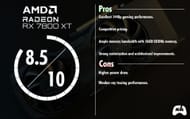Unveiled at Gamescom 2023, the AMD Radeon RX 7800 XT is AMD's notable venture into further capturing the 1440p gaming market. It is a space brimming with competition, including formidable offerings from Nvidia. This graphics card is a testament to AMD's ongoing endeavors to provide gamers with high-caliber hardware capable of delivering an exceptional gaming experience without breaking the bank.
In this review, we will scrutinize the Radeon RX 7800 XT, subjecting it to an array of benchmarks to ascertain its true capabilities and potential drawbacks. Our review unit was provided by AMD.
AMD Radeon RX 7800 XT pre-delivery
The AMD Radeon RX 7800 XT is engineered on a 5 nm process with the Navi 32 GPU at its core, utilizing the RDNA 3 architecture.
It comprises 60 compute units, embodying 3,840 stream processors, alongside 60 Ray Accelerators for ray tracing and 120 AI Accelerators for AI-based computations. The memory setup boasts 16 GB of GDDR6 memory operating at a speed of 19.5 Gbps on a 256-bit interface, translating to a bandwidth of 624 GB/s.
This GPU operates at a game frequency of 2124 MHz, boosting up to 2430 MHz in ideal conditions, with 240 TMUs and 96 ROPs for texture and pixel processing, respectively.
It also features 64 MB of Infinity Cache, enhancing memory speed. The RX 7800 XT requires dual 8-pin power connectors, with a maximum power draw of 263 W. These specifications position the RX 7800 XT as a formidable choice for high-resolution gaming and graphical rendering tasks.
Unboxing the AMD Radeon RX 7800 XT
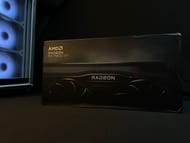
The packaging of the AMD Radeon RX 7800 XT embraces a minimalistic ethos, delivering a streamlined unboxing experience. The compact box unfolds in a clamshell manner, making the reveal of the graphics card inside a simple yet impactful moment. This approach underscores the GPU's significance, allowing it to take center stage without any distractions.
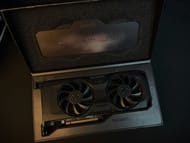
Upon opening, the essential contents -- the graphics card and the accompanying paperwork -- are presented in a straightforward manner, reflecting a purpose-driven packaging design.
A closer look at the AMD Radeon RX 7800XT reference design
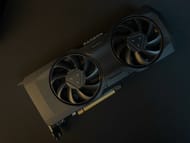
The reference design of the AMD Radeon RX 7800 XT exudes a different vibe compared to most of the AIB models available in the market. The reference design steers clear of any flamboyant aesthetics, favoring a more unassuming look. Here's a breakdown of the design elements based on the details:
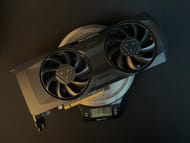
General Aesthetics:
- The reference design maintains a minimalist approach, steering clear of the flashy aesthetics often seen in gaming-oriented graphics cards.
- The card doesn't feature any RGB elements, which are a staple in modern gaming setups, setting a more professional tone.
Cooling Solution:
- The Radeon RX 7800 XT reference design comes with a dual-fan cooling setup, a slight step down from the triple-fan configuration seen in its higher-tier counterpart, the RX 7900 XT.
- Despite the reduced number of fans, the card employs a dense aluminum fin-stack heatsink ventilated by two axial-flow fans to ensure efficient heat dissipation during operation.
Build Quality:
- The reference design boasts a closed backplate, which could help in providing a more rigid structure to the card, protecting the PCB and aiding in heat dissipation.
Connectivity Options:
- The card features diverse connectivity options, with 3x DisplayPort 2.1 and 1x HDMI 2.1 outputs, enabling high frame rates for a smooth gaming and viewing experience.
Size and Form Factor:
- The reference model adopts a 2-slot design, ensuring compatibility with a wide range of PC cases and setups.
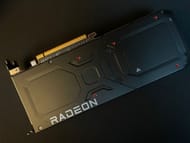
The reference design of the Radeon RX 7800 XT by AMD leans more towards functionality and performance rather than aesthetics. This design choice could appeal to a broad spectrum of users, especially those who prefer a more understated look for their PC build.
Test bench
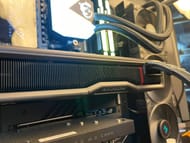
The following system was used to test the 7800 XT:
- CPU: AMD Ryzen 7 7800X3D
- Motherboard: Asus X670E Crosshair Hero
- RAM: Kingston Fury Beast RGB 2x 16 GB DDR5-6000
- Cooler: MSI C360 Liquid AIO
- Graphics card: AMD Radeon RX 7800 XT
- SSD: Micron 500GB Gen3 Nvme SSD
- PSU: Corsair RM1000e 1000W fully modular
- Case: Thermaltake Core P3 (Serving as an open-air test bench)
Productivity performance
In the subsequent segments, we will delve into how the Radeon RX 7800 XT fares when pitted against its rivals in a series of synthetic benchmarks.
The AMD Radeon RX 7800XT, with a score of 39,673, showcases impressive performance, outpacing several mid-range GPUs like the RTX 3070 and the RTX 3060 Ti. It even surpasses the AMD RX 7700XT and closely rivals the RTX 3080 Ti.
While it doesn't reach the heights of the RTX 4090 or AMD RX 7900 XTX, its score reflects its strong position as a strong GPU. It is particularly suitable for demanding gaming and rendering tasks, making it a competitive choice in its segment.
The Radeon RX 7800XT's performance in the Firestrike Extreme benchmark is remarkable, scoring 23,230. This positions it significantly ahead of competitors like the RTX 4070 and closely behind the more powerful RTX 3080 Ti.
Its strong showing in this high-resolution, graphically intensive benchmark underlines its capability as a versatile GPU, adept at handling advanced gaming and professional graphics tasks with commendable efficiency and power.
The AMD Radeon RX 7800XT's score of 17,592 in Time Spy is highly commendable. It outperforms the RTX 4070 and even edges past the RTX 3080 Ti, showcasing its strength in handling DirectX 12 tasks.
This performance makes it an attractive choice for users looking for a GPU that excels in modern gaming environments and future-proof applications. While it doesn't reach the pinnacle set by the RTX 4090, its score positions it firmly as a top-tier option for those seeking high-end performance without the highest price bracket.
In the Time Spy Extreme benchmark, designed to push PCs to their limits in 4K gaming, the AMD RX 7800XT scores an impressive 8,278. The trend remains constant.
With the 7800 XT edging out the RTX 4070, this can be a good option for mid-level 4K gaming. This balance of performance and cost makes it a particularly attractive option in the high-resolution gaming market.
In the 3DMark Ray Tracing feature test, the AMD RX 7800XT scores 31.43, placing it ahead of the RX 7700XT but below the RTX 4070 and 7900 XTX. This result highlights its mid-tier ray tracing performance.
While it's capable in this area, it's not at the forefront, especially compared to some of the higher-end RTX series GPUs. This should be a consideration for users prioritizing ray tracing in their gaming or rendering tasks.
In the 3DMark Port Royal benchmark, a test for ray tracing performance, the AMD RX 7800XT scores 10,016. This places it above the RX 7700XT and within the higher performance range, though still behind the RTX 4070 and notably lower than the RTX 4080 laptop, 3080 Ti, and 4090.
Its position suggests it's a capable option for ray tracing but not the top performer in this specific aspect. It makes AMD still the secondary option for most gamers looking for stellar ray tracing performance.
In the 3DMark Speedway benchmark, designed to assess DirectX Raytracing (DXR) performance, the AMD RX 7800XT scores 3,676. This places it above the RX 7700XT and RTX 4060 Ti, demonstrating its superior DXR capabilities in this mid-to-high-range segment. However, it's outperformed by the RTX 4080 laptop and 3080 Ti, indicating room for improvement in top-tier ray tracing scenarios.
The AMD RX 7800XT shows strong performance across all resolutions. At 1080p Extreme and 4K Optimized, its scores are comparable to the RTX 4070, indicating its strength in handling high and ultra-high resolutions.
However, at 8K Optimized, it falls behind the RTX 4090 and RX 7900 XTX, suggesting it's more suited for up to 4K gaming rather than 8K. This makes the RX 7800XT a solid choice for gamers targeting up to 4K resolution gaming.
The AMD RX 7800XT shows a significant improvement when upscaling is enabled, jumping from 54.87 FPS to 95.23 FPS. This indicates its strong capability in upscaling technologies, essential for maintaining high frame rates at higher resolutions. While it outperforms the RTX 4070 without any upscaling, it falls behind when upscaling is enabled.
This suggests that while the RX 7800XT is quite capable in upscaling scenarios, there are competitors with more efficient upscaling technologies. This is a factor for users to consider, especially those looking to game at higher resolutions with stable frame rates.
Gaming performance of the AMD Radeon RX 7800 XT
In the upcoming sections, we'll dive into how the AMD Radeon RX 7800 XT performs in various games. We'll kick things off with 1080p gaming, then move on to 1440p, and from there, we'll delve into the RT performance, path-tracing capabilities, and FSR.
In 1080p Ultra settings without FSR or ray tracing, the Radeon RX 7800 XT shows robust performance across various games. In graphically demanding games like Cyberpunk 2077 and Shadow of the Tomb Raider, it impressively maintains average frame rates above 100 FPS, ensuring smooth gameplay.
For instance, in Shadow of the Tomb Raider, it achieves an average of 142 FPS, with minimal frame drops, indicative of stable performance. In other titles like Far Cry 6 and Fortnite, it records high averages but experiences some dips in the 1% and 0.1% lows, suggesting occasional stutters.
Nonetheless, the RX 7800 XT consistently delivers a smooth gaming experience, making it a solid choice for high-definition gaming enthusiasts.
In 1440p Ultra settings without FSR or RTX, the Radeon RX 7800 XT delivers a commendable performance. It handles Cyberpunk 2077 smoothly with an average of 109 FPS, though there are very occasional dips to 30 FPS. In Far Cry 6, it achieves a solid 139 FPS average, ensuring a fluid gaming experience.
Fortnite, while averaging a lower 70 FPS, still maintains playable frame rates. Titles like Atomic Heart and Shadow of the Tomb Raider are handled exceptionally well, with averages of 124 and 143 FPS, respectively.
The Witcher 3 and Watch Dogs Legion show good performance, especially in maintaining higher 1% and 0.1% lows. Forspoken, at 85 FPS, demonstrates the GPU's capability to handle diverse gaming scenarios effectively at 1440p.
At 1440p Ultra with ray tracing enabled but without FSR, the Radeon RX 7800 XT shows varied performance. In Cyberpunk 2077, it manages an average of 28 FPS, indicating the demanding nature of RT. Far Cry 6 sees a higher average of 115 FPS but with significant dips in 1% and 0.1% lows.
Fortnite and Shadow of the Tomb Raider present playable but less fluid experiences at 55 and 91 FPS, respectively. The Witcher 3 and Watch Dogs Legion hover around the 30-50 FPS range. Forspoken, averaging 64 FPS, demonstrates the GPU's ability to handle RT at 1440p, albeit with noticeable performance variations.
When running Cyberpunk 2077 with path tracing at 1440p Ultra settings, the Radeon RX 7800 XT shows a stark contrast in performance with and without FSR. Without FSR, the average FPS drops to 8, with both 1% and 0.1% lows at 6, indicating the intense demand of path tracing on the GPU.
However, when FSR is enabled, there's a significant improvement to a 28 FPS average, with lows at 21 and 17 FPS. This demonstrates the effectiveness of FSR in enhancing frame rates in highly demanding graphical settings like path tracing
The Radeon RX 7800 XT's performance is greatly enhanced with FSR enabled. In Cyberpunk 2077, the frame rate increases dramatically from 28 FPS to 147 FPS with FSR. A similar trend is observed in Far Cry 6, where FPS rises from 115 to 143.
The Witcher 3 also benefits significantly, with FPS more than doubling from 34 to 63. Notably, Forspoken, using FSR 3.0, shows the most remarkable improvement, soaring from 64 FPS to an impressive 208 FPS. These results underscore the effectiveness of FSR, particularly the latest FSR 3.0, in boosting gaming performance on the RX 7800 XT.
In conclusion
The AMD Radeon RX 7800 XT emerges as a powerful contender in the 1440p gaming market. Its impressive performance in benchmarks makes it a compelling choice for gamers and professionals alike.
The 16 GB of GDDR6 memory, along with the robust RDNA 3 architecture, ensures that it delivers top-tier gaming and rendering capabilities. The GPU's ability to maintain high frame rates in demanding games at 1440p speaks volumes about its efficiency.
The RX 7800 XT's performance is further enhanced by features like FSR (FidelityFX Super Resolution), which significantly boosts frame rates in resource-intensive gaming scenarios. This makes it a versatile choice for a range of games and applications, providing a smooth and immersive experience.
On the flip side, the slightly higher power draw of the RX 7800 XT might be a concern for some. Its ray tracing performance, while competent, doesn't quite match the highest standards set by some competitors. This aspect may affect users who prioritize ray tracing.
Overall, with its competitive pricing, the AMD Radeon RX 7800 XT offers excellent value for money, particularly for those targeting high-end performance at 1440p. It stands out as a formidable choice for gamers who seek a balance between cost and high-end gaming performance, making it a strong contender in its segment.
AMD Radeon RX 7800 XT
